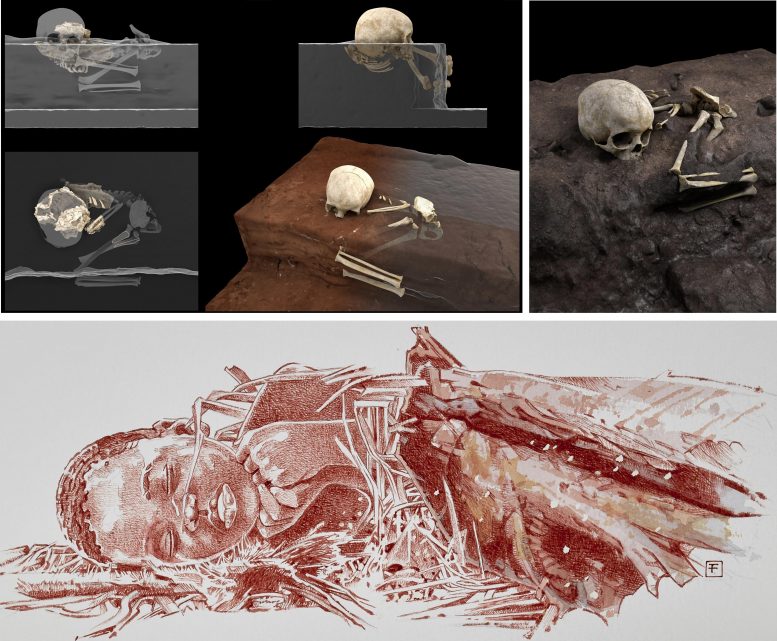General view of the cave site of Panga ya Saidi. Note trench excavation where burial was unearthed. Credit: Mohammad Javad Shoaee
The discovery of the earliest human burial site yet found in Africa, by an international team including several CNRS researchers,[1] has just been announced in the journal Nature.
At Panga ya Saidi, in Kenya, north of Mombasa, the body of a three-year-old, dubbed Mtoto (Swahili for ‘child’) by the researchers, was deposited and buried in an excavated pit approximately 78,000 years ago. Through analysis of sediments and the arrangement of the bones, the research team showed that the body had been protected by being wrapped in a shroud made of perishable material, and that the head had likely rested on an object also of perishable material.

3D reconstruction of the arrangement of the child’s remains (top), artistic reconstruction of the burial (bottom). Credit: Jorge González / Elena Santos / F. Fuego / MaxPlanck Institute / CENIEH
Though there are no signs of offerings or ochre, both common at more recent burial sites, the funerary treatment given Mtoto suggests a complex ritual that likely required the active participation of many members of the child’s community.
Though Mtoto was a Homo sapiens, the child’s dental morphology, in contrast with that observed in human remains of the same period, preserves certain archaic traits connecting it to distant African ancestors. This apparently confirms that, as has often been posited in recent years, our species has extremely old and regionally diverse roots in the African continent where it arose.
Notes
- Participating CNRS researchers hail from the PACEA (CNRS / University of Bordeaux / French Ministry of Culture) and IRAMAT (CNRS / Université Bourgogne Franche-Comté / University of Orléans / Bordeaux Montaigne University) research units. In France, this research was funded by the LaScArBx Laboratory of Excellence (LabEx).
For more on this research, read Africa’s Oldest Human Burial Site Uncovered: 78,000-Year-Old Remains Reveal How Stone Age Populations Interacted With the Dead.
Reference: “Earliest known human burial in Africa” by María Martinón-Torres, Francesco d’Errico, Elena Santos, Ana Álvaro Gallo, Noel Amano, William Archer, Simon J. Armitage, Juan Luis Arsuaga, José María Bermúdez de Castro, James Blinkhorn, Alison Crowther, Katerina Douka, Stéphan Dubernet, Patrick Faulkner, Pilar Fernández-Colón, Nikos Kourampas, Jorge González García, David Larreina, François-Xavier Le Bourdonnec, George MacLeod, Laura Martín-Francés, Diyendo Massilani, Julio Mercader, Jennifer M. Miller, Emmanuel Ndiema, Belén Notario, Africa Pitarch Martí, Mary E. Prendergast, Alain Queffelec, Solange Rigaud, Patrick Roberts, Mohammad Javad Shoaee, Ceri Shipton, Ian Simpson, Nicole Boivin and Michael D. Petraglia, 5 May 2021, Nature.
DOI: 10.1038/s41586-021-03457-8













 English
English French
French Spanish
Spanish German
German Dutch
Dutch Italian
Italian Danish
Danish Portuguese
Portuguese Greek
Greek Russian
Russian Swedish
Swedish Bulgarian
Bulgarian Hungarian
Hungarian Catalan
Catalan Ukrainian
Ukrainian Polish
Polish Basque
Basque Chinese (Simplified)
Chinese (Simplified) Japanese
Japanese Hebrew
Hebrew Arabic
Arabic Swahili
Swahili Amharic
Amharic Irish
Irish Afrikaans
Afrikaans Albanian
Albanian Armenian
Armenian Azerbaijani
Azerbaijani Belarusian
Belarusian Bengali
Bengali Bosnian
Bosnian Cebuano
Cebuano Chichewa
Chichewa Chinese (Traditional)
Chinese (Traditional) Corsican
Corsican Croatian
Croatian Czech
Czech Esperanto
Esperanto Estonian
Estonian Filipino
Filipino Finnish
Finnish Frisian
Frisian Galician
Galician Georgian
Georgian Gujarati
Gujarati Haitian Creole
Haitian Creole Hausa
Hausa Hawaiian
Hawaiian Hindi
Hindi Hmong
Hmong Icelandic
Icelandic Igbo
Igbo Indonesian
Indonesian Javanese
Javanese Kannada
Kannada Kazakh
Kazakh Khmer
Khmer Korean
Korean Kurdish (Kurmanji)
Kurdish (Kurmanji) Kyrgyz
Kyrgyz Lao
Lao Latin
Latin Latvian
Latvian Lithuanian
Lithuanian Luxembourgish
Luxembourgish Macedonian
Macedonian Malagasy
Malagasy Malay
Malay Malayalam
Malayalam Maltese
Maltese Maori
Maori Marathi
Marathi Mongolian
Mongolian Myanmar (Burmese)
Myanmar (Burmese) Nepali
Nepali Norwegian
Norwegian Pashto
Pashto Persian
Persian Punjabi
Punjabi Romanian
Romanian Samoan
Samoan Scottish Gaelic
Scottish Gaelic Serbian
Serbian Sesotho
Sesotho Shona
Shona Sindhi
Sindhi Sinhala
Sinhala Slovak
Slovak Slovenian
Slovenian Somali
Somali Sundanese
Sundanese Tajik
Tajik Tamil
Tamil Telugu
Telugu Thai
Thai Turkish
Turkish Urdu
Urdu Uzbek
Uzbek Vietnamese
Vietnamese Welsh
Welsh Xhosa
Xhosa Yiddish
Yiddish Yoruba
Yoruba Zulu
Zulu